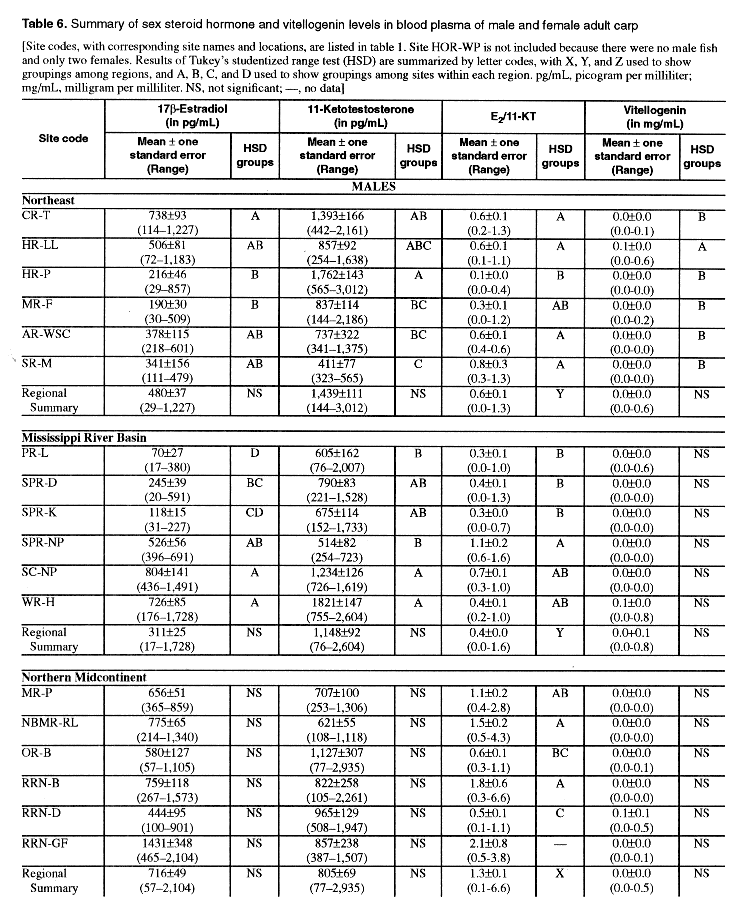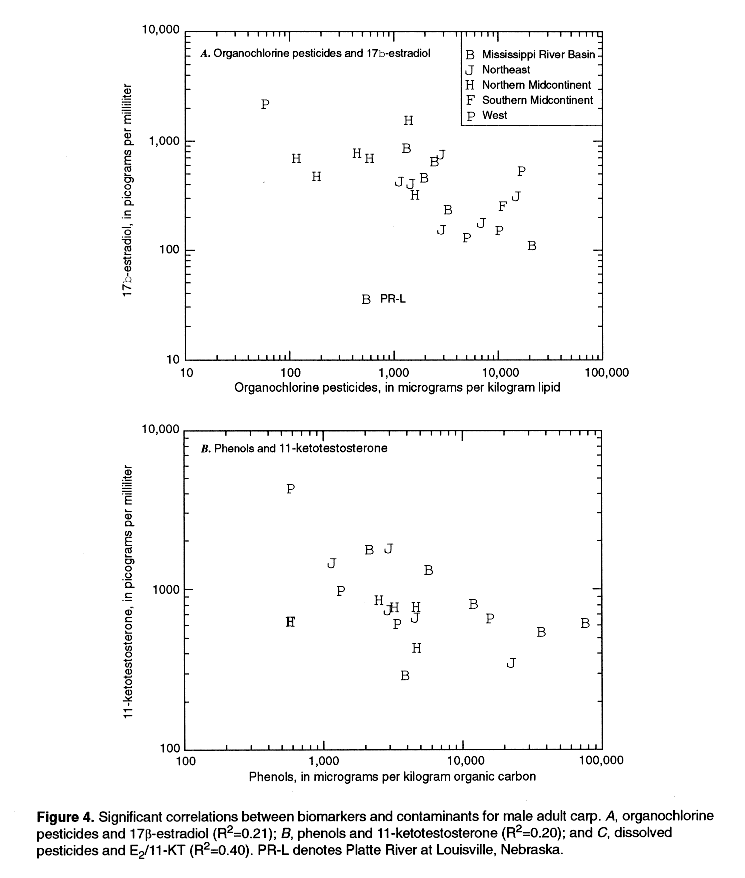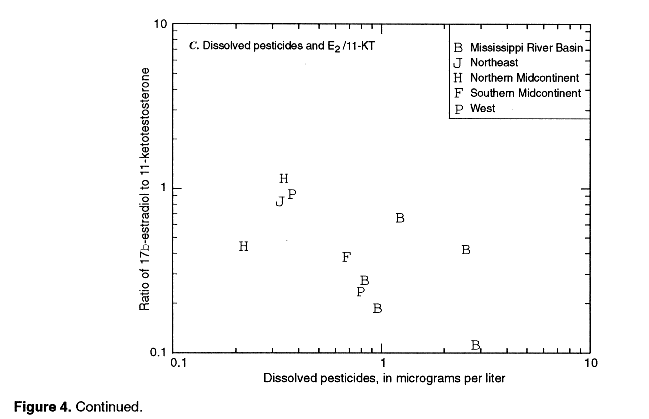National Water-Quality Assessment (NAWQA) Project
Go to:
U.S. Geological Survey Open-File Report 96-627



Variations in mean hormone levels for sites within geographic regions are generally much less than the national variation (usually less than 1 order of magnitude). Nevertheless, within most regions, there were significant differences in plasma hormone concentrations between some sites. In all regions except the Northern Midcontinent and the Mississippi River Basin, there were significant differences in 17ßestradiol and 11-ketotestosterone levels for males and females. In the Mississippi River Basin, there were differences between sites in both hormones for males and in 17ß-estradiol levels for females. In the Northern Midcontinent, where variability was high at each site, there were no significant differences for either hormone for either males or females.
Another way to evaluate sex steroid hormones is to examine their ratios. In this study, all mean ratios of 17ß-estradiol to 11-ketotestosterone (E2/11-KT) for female carp were above 1.0, whereas mean ratios for male carp were generally below 1.0. Four sites in the Northern Midcontinent had mean E2/11-KT ratios above 1.0 for males. Significant differences in E2/11KT ratios were found between sites in all regions for males, whereas for females, only the Northern Midcontinent and the Southern Midcontinent had no significant site-to-site differences.
Mean plasma vitellogenin in female carp ranged from 8.1 mg/mL for the Mill Race Pond at Springfield, Oregon (MRP-S) to 37.8 mg/mL for the San Joaquin River at Mossdale, California (SJR-M). The highest individual plasma vitellogenin for a female was 87.8 mg/mL from Red River of the North at Grand Forks, North Dakota (RRN-GF). A few females at several sites had no detectable vitellogenin. Male carp had detectable vitellogenin in one or more individuals at 13 of the 25 sites, including at least one site in every region except the Southern Midcontinent. Mean values were much lower in males than females, with the highest being 0.1 mg/mL (found at four sites). The highest individual male plasma vitellogenin con-centration was only 0.8 mg/mL, two orders of magnitude lower than the highest female concen-tration. The only significant difference between sites evident from the sparse detections of vitellogenin in males was between the Hudson River south of Lake Luzerne, New York (HRLL) and all other sites in the Northeast. For females, there were significant differences in vitellogenin levels between sites within the Northeast, Mississippi River Basin, and the West.
Histopathological analyses of carp testes showed that all 216 males evaluated had at least some spermatogenic activity. Most fish had moderate or high spermatogenic activity, indicating a recrudescent reproductive period. However, 86 percent of fish from the Shenandoah and Anacostia Rivers had low sper-matogenic activity, which is associated with a late stage of sexual maturation and may be related to the late November sampling dates. All fish with low spermatogenic activity were not used in any statistical data analyses. One male from the Shenandoah River had a few large basophilic cells resembling perinucleolar oocytes (fig. 3), which may be attributed to contaminant exposure and endocrine disruption. All other male gonadal tissue examined in this study was normal.
Ovaries in all but twenty of the female fish were vitellogenic and had varying stages of developing ova, again indicating recrudescence. Abnormalities, such as multinuclear ova, sometimes associated with endocrine disruption, were not seen in any female carp from this study. The general gonadal condition for both male and female carp was similar for all sites and regions and indicated a similar stage of sexual maturation.


Organochlorine pesticide concentrations in tissues were detected at all but two sites, with total con-centrations ranging from 5 to 1,310 ug/kg wet weight (ww). The South Platte River near Kersey, Colorado (SPR-K), and Hudson River near Poughkeepsie, New York (HR-P), had total tissue organochlorine pesticide concentrations above 1,000 ug/kg ww. Don Pedro Reservoir, California (DPR) and Clear Creek near Sanger, Texas (CC-S) had no detectable organochlorine pesticides. Total PCBs in tissue follow a regional pattern, with the four highest concentrations occurring in the Northeast. The South Platte River at Denver, Colorado (SPRD), a site affected by urban development, was the only site outside of the Northeast with a concentration greater than 1,000 ug/kg ww. Ten sites had no detectable PCBs in tissue.
Phenol concentrations in bed sediment were usually less than 100 ug/kg dry weight (dw), with only the Mill Race Pond at Springfield, Oregon (MRP-S), exceeding 1,000 ug/kg dw. Only three sites had no detectable phenols. Phthalates in bed sediment were frequently over 10 ug/kg dw, but only the South Platte at Denver, Colorado (SPR-D), with 2,300 ug/kg dw, had a concentration greater than 1,000 ug/kg dw. Concentrations of PAHs generally were higher than phenols and phthalates. Nine sites had PAH concentrations higher than 1,000 ug/kg dw, with the highest of 13,300 ug/kg dw found in the South Platte River at Denver, Colorado (SPR-D). PAHs were found at all sites except Clear Creek near Sanger, Texas (CCS).
Different organic contaminants are frequently found together in the environment and this cooccurrence is important to consider when evaluating possible biological effects. The Pearson product-moment correlation matrix of log-transformed contaminant data shows significant (a=0.05) correlations between PCBs and organochlorine pesticides, PCBs and PAHs, PAHs and phthalates, and phthalates and phenols (table 8). There were no significant correlations between dissolved pesticides in water and any contaminant group in tissue or bed sediment. Principal component analysis based on the correlation matrix for log-transformed data was used to examine patterns in bed sediment and tissue contaminants among sites (table 9). The first principal component accounts for 50 percent of the total variance and is composed of an almost equally weighted sum of all contaminant groups. The second component accounts for 24 percent of the variance and has high positive loadings for organochlorine pesticides (0.66) and PCBs (0.39), which are correlated with each other, and negative loadings for phenols (--0.45) and phthalates (--0.46). The third component accounts for 15 percent of the variance and has high positive loadings for phenols (0.69) and organochlorine pesticides (0.54). The second and third components indicate that the relative proportions of phenols, phthalates, and organochlorine pesticides account for Most of the total variability in contaminants after variations in total contaminant levels are accounted for.



Among the biomarkers, there is a significant correlation (a=0.05) between the two major sex steroid hormones, 17ß-estradiol and 11-ketotestosterone, but variation in the E2/11-KT ratio is mainly determined by 17ß-estradiol. The detection frequency of vitellogenin in the male carp was not correlated significantly with either of the two steroid hormones or E2/11-KT.
Correlation coefficients between 17ßestradiol in male carp and all contaminant groups are negative, but the only significant correlation is with organochlorine pesticides (fig. 4A). With removal of one extreme outlier (PR-L), the proportion of variance in 17ßestradiol that is explained by organochlorine pes-ticides in tissue increases from 21 to 48 percent. Multiple regression relations were examined by stepwise addition to the correlation with organochlorine pesticides, but there were no significant additions.
Correlation coefficients between 11-ketotestosterone and contaminant groups are either negative or close to zero, with a significant negative correlation with phenols. Phenols in bed sediments explain 20 percent of the variance in median 11-ketotestosterone among sites (fig. 4B). No other contaminant groups were found to be significant additions to the phenol relation in stepwise multiple regression analysis.
Correlation coefficients between the E2/11-KT ratio and all contaminant groups also are negative, reflecting the dominant influence of negative correlations with levels of 17ßestradiol. There is a significant negative correlation with dissolved pesticides. The timeweighted mean dissolved pesticide concentration explained 40 percent of the variance in the E2/11-KT ratio for the 11 sites with dissolved pesticides data (fig. 4C). Examination of multiple regression relations showed that phthalates were a significant addition to the regression relation for dissolved pesticides, also with a negative coefficient. The addition of phthalates increased the variance explained from 40 to 65 percent for the 11 sites. Although the data set for this multiple regression relation is small and does not support conclusive analysis, the significant relation is consistent with the occurrence of simultaneous influences of multiple contaminants. The detection frequency of vitellogenin in male carp was not significantly correlated with any of the contaminant groups.


Figure 4 shows varying degrees of consistency between small regional subsets of data and the national data for the statistically significant correlations between biomarkers and contaminants for male carp. Generally, within-region correlations are insignificant or are controlled by one or two observations. The small number of sites per region, the uncontrolled variability, and the possibility that other contaminant factors not measured in this study may be the dominant influence at a particular site, combine to make detailed interpretation of individual relations within each region inappropriate from this reconnaissance data.

Correlation coefficients between 11-ketotestosterone in female carp and contaminant groups also vary in both direction and magnitude. There is one significant positive correlation with dissolved pesticides (fig. 5A). No other contaminant groups were found to be significant additions to this relation in stepwise multiple regression analysis.
Correlation coefficients between the E2/11-KT ratio and contaminant groups are mostly low, but there is a significant negative correlation with dissolved pesticides that explains 71 percent of the variance in E2/11KT (fig. 5B). Examination of multiple regression relations showed that PCBs are a significant addition to the dissolved pesticide relation with a positive coefficient, and increased the variance explained to 92 percent (HOR-WP is not included because there are no dissolved pesticide data for that site). Vitellogenin in female carp is not significantly correlated with any of the contaminant groups.
As for males, figure 5 shows varying degrees of consistency between small regional subsets of data and the national data for the two statistically significant correlations between biomarkers and contaminants for female carp. Particularly for dissolved pesticides, the number of sites in each region is small (five in the Mississippi River Basin and two or less in others). Generally, within-region correlations are insignificant or are governed by one or two observations. As stated for males, the small number of sites per region, the uncontrolled variability in the data, and the possibility that other contaminant factors may be the dominant influence at a particular site, make detailed interpretation of individual relations within each region inappropriate.
